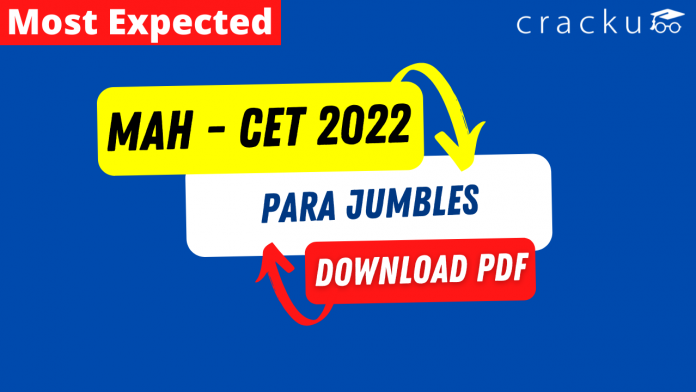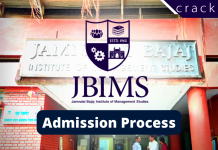Para Jumbles Questions for MAH – CET 2022 – Download PDF
Here you can download CMAT 2022 – important MAH – CET Para Jumbles Questions PDF by Cracku. Very Important MAH – CET 2022 and These questions will help your MAH – CET preparation. So kindly download the PDF for reference and do more practice.
Download Para Jumbles Questions for MAH – CET
Enroll to MAH-CET Crash Course
Instructions
Rearrange the following six sentences (A), (B), (C), (D), (E) and (F) in the proper sequence to form a meaningful paragraph; then answer the questions given below them.
(A) To address these issues Indian corporate are increasingly turning eco-friendly
(B) At present however there are only a dozen green buildings in the private sector.
(C) However though an eco-friendly building may cost more upfront however it is cost effective because of lower operating costs in long run.
(D) Today there is growing concern about global warming, energy and water crises.
(E) The reason is the construction cost of an eco-friendly building is 15% to 20% more than putting up a conventional building.
(F) Planting trees, using energy saving lighting systems and constructing eco-friendly green buildings are some of the measure they are taking.
Question 1: Which of the following will be the SIXTH (LAST) sentence after rearrangement?
a) B
b) C
c) D
d) E
e) F
Question 2: Which of the following will be the FIFTH sentence after rearrangement?
a) C
b) D
c) E
d) F
e) A
Question 3: Which of the following will be the THIRD sentence after rearrangement?
a) B
b) D
c) C
d) E
e) F
Question 4: Which of the following will be the SECOND sentence after rearrangement?
a) A
b) C
c) D
d) E
e) F
Question 5: Which of the following will be the FIRST sentence after rearrangement?
a) A
b) B
c) C
d) D
e) E
Take Free MAH-CET mock tests here
Instructions
Directions: Rearrange the following seven sentences (A), (B), (C), (D), (E), (F) and (G) in the proper sequence to form a meaningful paragraph; then answer the questions given below them.
(A) To elaborate briefly on these characteristics and dimensions that the author is talking about —NRMs are general tests intended to be used to classify students by percentile for measuring either aptitude or proficiency for admissions into or placement within a programme.
(B) Contrastingly, the CRM, such as a locally produced achievement test, measures absolute performance that is compared only with the learning objective, hence a perfect score is theoretically obtainable by all students who have a mastery of the pre- specified material, or conversely, all students may fail the test.
(C) In most of these books, the authors classify a measurement strategy as either norm-referenced (NRM) or criterion-referenced (CRM).
(D) Another author points out how the type of interpretation that an NRM offers is the relative performance of the students compared with that of all the others resulting in, ideally, a bell curve distribution.
(E) Numerous books on constructing and using language tests have been written by various authors.
(F) CRMs, on the other hand, are more specific achievement or diagnostic tests intended to be used for motivating students by measuring to what per cent they have achieved mastery of the taught or learned material.
(G)One of the authors clearly delineates the differences of these two types by focusing on the categories of “test characteristics” and “logistical dimensions”.
Question 6: Which of the following should be the SECOND sentence after rearrangement?
a) A
b) B
c) C
d) D
e) F
Question 7: Which of the following should be the THIRD sentence after rearrangement?
a) A
b) B
c) G
d) D
e) E
Question 8: Which of the following should be the SEVENTH (LAST) sentence after rearrangement?
a) A
b) B
c) C
d) D
e) E
Question 9: Which of the following should be the FIFTH sentence after rearrangement?
a) A
b) B
c) C
d) F
e) E
Question 10: Which of the following should be the FIRST sentence after rearrangement?
a) G
b) B
c) C
d) D
e) E
Get 5 MAH-CET mocks at just Rs.299
Answers & Solutions:
1) Answer (B)
The first sentence in the paragraph is (d) because it introduces the subject and indicates the time and tense of the issue. Sentence (a) builds on it and is hence the second line. (f) is a continuation of (A) and gives some examples of how to be eco-friendly. (e) and (c) are the last two sentences as they close the discussion.
2) Answer (C)
The first sentence in the paragraph is (d) because it introduces the subject and indicates the time and tense of the issue. Sentence (a) builds on it and is hence the second line. (f) is a continuation of (A) and gives some examples of how to be eco-friendly. (e) and (c) are the last two sentences as they close the discussion.
3) Answer (E)
The first sentence in the paragraph is (d) because it introduces the subject and indicates the time and tense of the issue. Sentence (a) builds on it and is hence the second line. (f) is a continuation of (A) and gives some examples of how to be eco-friendly. (e) and (c) are the last two sentences as they close the discussion.
4) Answer (A)
The first sentence in the paragraph is (d) because it introduces the subject and indicates the time and tense of the issue. Sentence (a) builds on it and is hence the second line. (f) is a continuation of (A) and gives some examples of how to be eco-friendly. (e) and (c) are the last two sentences as they close the discussion. The meaningful paragraph should be: To day there is growing concern about globle warming energy and water crises. To address these issues……
5) Answer (D)
The first sentence in the paragraph is (d) because it introduces the subject and indicates the time and tense of the issue. Sentence (a) builds on it and is hence the second line. (f) is a continuation of (A) and gives some examples of how to be eco-friendly. (e) and (c) are the last two sentences as they close the discussion.
6) Answer (C)
The correct order is ECGAFDB. E opens the paragraph by introducing the subject – constructing and using language tests. This is followed by C, which talks about the different types of measurement strategies. G, which talks about how one author differentiates between the two measuring strategies comes next. A and F, which talk about each of the measuring strategies in greater detail follow G. F comes next and it introduces the work of another author. This is followed by B which throws more light on the work of the second author.
So, C is the second sentence.
7) Answer (C)
The correct order is ECGAFDB. E opens the paragraph by introducing the subject – constructing and using language tests. This is followed by C, which talks about the different types of measurement strategies. G, which talks about how one author differentiates between the two measuring strategies comes next. A and F, which talk about each of the measuring strategies in greater detail follow G. F comes next and it introduces the work of another author. This is followed by B which throws more light on the work of the second author.
So, G is the third sentence.
8) Answer (B)
The correct order is ECGAFDB. E opens the paragraph by introducing the subject – constructing and using language tests. This is followed by C, which talks about the different types of measurement strategies. G, which talks about how one author differentiates between the two measuring strategies comes next. A and F, which talk about each of the measuring strategies in greater detail follow G. F comes next and it introduces the work of another author. This is followed by B which throws more light on the work of the second author.
So, B is the last sentence.
9) Answer (D)
The correct order is ECGAFDB. E opens the paragraph by introducing the subject – constructing and using language tests. This is followed by C, which talks about the different types of measurement strategies. G, which talks about how one author differentiates between the two measuring strategies comes next. A and F, which talk about each of the measuring strategies in greater detail follow G. F comes next and it introduces the work of another author. This is followed by B which throws more light on the work of the second author.
So, F is the fifth sentence.
10) Answer (E)
The correct order is ECGAFDB. E opens the paragraph by introducing the subject – constructing and using language tests. This is followed by C, which talks about the different types of measurement strategies. G, which talks about how one author differentiates between the two measuring strategies comes next. A and F, which talk about each of the measuring strategies in greater detail follow G. F comes next and it introduces the work of another author. This is followed by B which throws more light on the work of the second author.
So, E is the first sentence.





